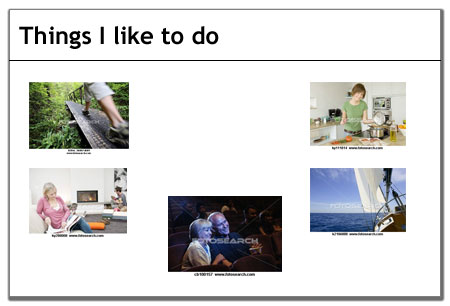You may have noticed a potential misuse of the word “principal” in the headline of this blog. But it was no accident: the subject of this blog is the new principal of my sons’ school. She gave a PowerPoint presentation that violated one of the main principles of the use of copyrighted images: you must pay for what you use.
The new principal was hosting a meet-and-greet to introduce herself and was telling us about her background. One of her slides detailed her hobbies, and looked something like this:
Apart from the fact that these images are tiny and therefore don’t communicate as well as they would if they were larger, they are clearly cut and pasted from a Web site, as indicated by the watermarks and the file information that appears below each one. I don’t think it made an impression on anybody else in the audience, but it made a profound one on me.
Photographers make money from the sale or licensing of their images. That’s why photo processing centers will not make duplicates of any photographs that bear the photographer’s or studio’s copyright mark, and it’s also why a portrait session with a professional photographer generally doesn’t cost a lot (they make their money by selling prints).
The Web has been both a blessing and a curse for photographers. On the one hand, it’s easy to get one’s work seen by a vast audience of potential clients. On the other hand, it’s incredibly easy to copy images from a Web site and paste it into whatever one wants. For free. And that amounts to stealing.
Photographers and royalty-free photo sellers such as iStockphoto, Getty Images, and Veer imprint all images with a watermark, usually a logo going right across the center of the image. It is supposed to prevent people from using images they haven’t purchased or licensed, but in this case it wasn’t enough of a deterrent.
While this instance of copyright infringement didn’t register with this group, imagine if someone did this in a corporate setting, say at a keynote presentation, annual sales meeting, or client pitch. The presenter would be demonstrating that:
- He didn’t pay for the artwork
- He doesn’t care if everybody knows it
Realistically, there is very little that photographers and their agents can do to prevent this type of copyright infringement. There are no Copyright Police who surreptitiously attend corporate meetings. You are not going to jail for snagging a picture from flickr and not correctly attributing it. And people typically are not going to report you for engaging in this practice. Legally, though, it is stealing. Ethically, stealing is wrong. By not paying for images we use in our presentations, we are saying that stealing is OK sometimes if nobody catches us doing it. Is that true?
You can be sure that I will be speaking with our new principal about copyright issues and the unconscious messages she’s sending so that she doesn’t make the same mistake again.

